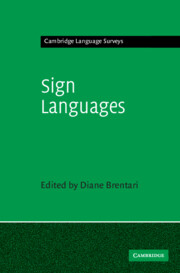Book contents
- Frontmatter
- Contents
- List of figures
- List of tables
- List of contributors
- List of sign language abbreviations
- Notational conventions
- 1 Introduction
- I HISTORY AND TRANSMISSION
- II SHARED CROSSLINGUISTIC CHARACTERISTICS
- 8 Notation systems
- 9 Verb agreement in sign language morphology
- 10 Functional markers in sign languages
- 11 Clause structure
- 12 Factors that form classifier signs
- 13 Handshape contrasts in sign language phonology
- 14 Syllable structure in sign language phonology
- 15 Grammaticalization in sign languages
- 16 The semantics–phonology interface
- 17 Nonmanuals: their grammatical and prosodic roles
- III VARIATION AND CHANGE
- Notes
- References
- Index
16 - The semantics–phonology interface
from II - SHARED CROSSLINGUISTIC CHARACTERISTICS
Published online by Cambridge University Press: 05 June 2012
- Frontmatter
- Contents
- List of figures
- List of tables
- List of contributors
- List of sign language abbreviations
- Notational conventions
- 1 Introduction
- I HISTORY AND TRANSMISSION
- II SHARED CROSSLINGUISTIC CHARACTERISTICS
- 8 Notation systems
- 9 Verb agreement in sign language morphology
- 10 Functional markers in sign languages
- 11 Clause structure
- 12 Factors that form classifier signs
- 13 Handshape contrasts in sign language phonology
- 14 Syllable structure in sign language phonology
- 15 Grammaticalization in sign languages
- 16 The semantics–phonology interface
- 17 Nonmanuals: their grammatical and prosodic roles
- III VARIATION AND CHANGE
- Notes
- References
- Index
Summary
Introduction
The analysis in this chapter addresses the question of why sign languages look more similar to each other than spoken languages do. It is generally recognized that this has something to do with the “form–meaning mapping,” but previous attempts at addressing this question have been limited in their scope. It will be necessary to take a fresh look at “form” and “meaning” so that the relationship between them can be carefully described without confusion in the uses of words like “path” and “event.” Additionally, special attention will be paid to the various linguistic levels, notably “morpheme,” “lexical item,” “verb phrase,” and “clause,” in order to be clear about the claims. The model presented has been tested most extensively on American Sign Language (ASL) and Austrian Sign Language (ÖGS) (Wilbur 2003, 2005, 2008; Schalber 2004, 2006; Schalber & Grose 2006; Grose, Wilbur & Schalber 2007; Grose 2008).
Traditionally, the relationship between semantics (meaning) and phonology (form) has been taken as an arbitrary mapping into morphemes stored in the lexicon and learned individually during the acquisition process. Such arbitrariness has been considered a defining characteristic of “true” language (Saussure 1916, Hockett 1960). Onomatopoetic words have been considered to be the only exceptions to the arbitrariness requirement. Gasser (2004, Gasser, Sethuraman & Hockema 2005) argues from experimental data that “arbitrariness makes sense” to help keep large numbers of form–meaning associations separate by treating them as categories.
- Type
- Chapter
- Information
- Sign Languages , pp. 355 - 380Publisher: Cambridge University PressPrint publication year: 2010
- 21
- Cited by

